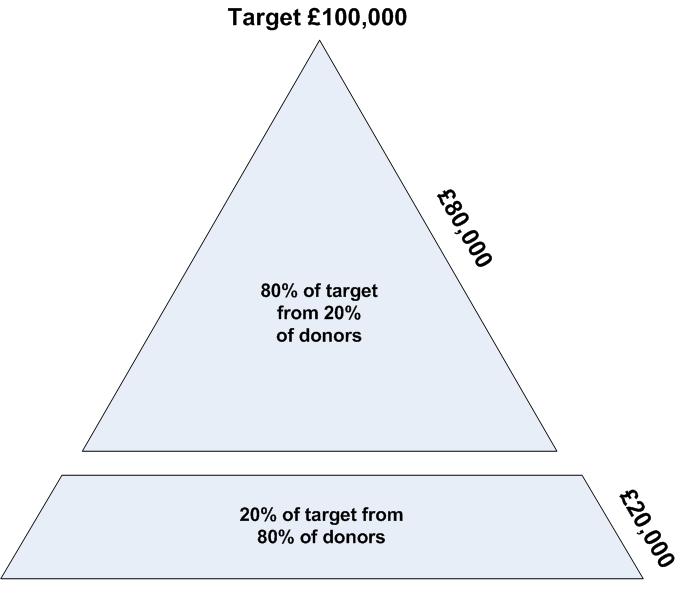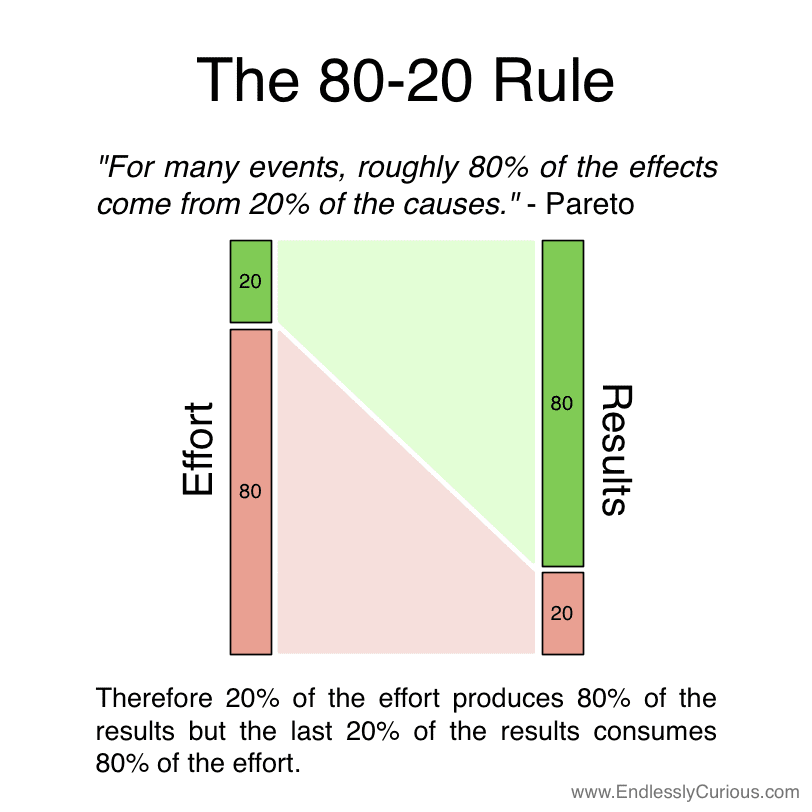You have probably already heard about the Pareto Principle. It states that 80 % of consequences come from 20 % of the causes. Do you know how to use this rule?

In the late 19th century, the Italian economist Vilfredo Pareto found out that four-fifths of the national wealth was held by one-fifth of the economically active population.
Pareto was very surprised when he discovered that the same ratio applies to land ownership. Back then, eighty percent of the land in Italy was owned by twenty percent of the population. And when investigating other countries, he found the same unequal distribution of income and wealth.

From Pea Cultivation to Programming
Pareto discovered this universal Principle when he noticed that twenty percent of the pea pods in his garden produced eighty percent of the peas. And he revealed even more findings:
- Eighty percent of your sales are made by twenty percent of your sales staff
- Twenty percent of a company's retailers produce eighty percent of profit
- Twenty percent of your working hours produce eighty percent of your results
- Twenty percent of your customers represent eighty percent of your sales
This Principle can also be applied in the opposite way:
- Software developers spend eighty percent of their time on twenty percent of the software’s features
- Twenty percent of the hazards in a workplace cause eighty percent of the injuries
- Twenty percent of the healthcare patients in the United States use eighty percent of the healthcare resources
Pareto Principle in Marketing Communication
Marketing strategist Perry Marshall decided to develop the Pareto Principle further and focused on the crucial twenty percent. Let's say that twenty percent of your customers are responsible for eighty percent of your sales. Take that twenty percent and analyse it. What you will discover is that twenty percent of that group (twenty percent of twenty percent) are responsible for eighty percent of those sales. And then, if you take that twenty percent, you can apply the Pareto Principle again!
How can you use the Pareto Principle in your marketing communication? We introduced you one example of its practical use in the article Classification of Customers Based on the ABC Method. However, you can apply the Pareto Principle to plan advertising campaigns, create web content, or select suitable posts for your company profiles on social networks.

Twenty Percent of Your Customers Represent Eighty Percent of Your Sales
This is Pareto's key finding. You can easily find out if it applies to your business. If the vast majority of your profits comes from twenty percent of your customers, you should not only identify them but also treat them well and try to find new buyers who are similar to this one fifth!
Carefully follow the traffic channels which this group discovered and tailor the advertising message to their needs and preferences. Optimize the content preferred by the target group and work with media channels which show the highest affinity to your key customers.
Perform a demographic and psychographic study on those twenty percent of your most valuable customers. The better you get to know them, the better you can approach them. Do not waste time and money trying to communicate with all your customers, because they do not generate the majority of your income. Concentrate on the economically active minority, which brings you the most significant benefit.
Eighty Percent of Your Online Sales Come from Twenty Percent of Your Products
What type of products do you offer? If the Pareto Principle can be applied to your business, then you have a group of products which generates eighty percent of your sales. These are the products you should promote as much as possible! They are successful for a reason and, therefore, deserve your utmost attention.
Eighty Percent of Your Webpage Visitors Come from Twenty Percent of Your Keywords
Do you spend a lot of time looking for the best keywords, creating SEO strategies and applying them to your website? According to Pareto Principle, eighty percent of your keywords have no effect, and some experts in online advertising say that the final ratio is even higher! Have a look on Google Analytics and SEMrush and find out what factors of your online communication are important for your business. Find out what your visitors seek and offer them the most original content on topics that interest them.
Eighty Percent of Your Content Marketing Leads Comes from Twenty Percent of Your Content
Everyone knows that the power of content marketing is enormous. But do you know what content generates the necessary marketing leads, which is to say the visits of your future and current customers? According to the Pareto Principle, it is a mere fifth of the content that you create on your website. Often, you find out that the majority of potential customers was attracted to visit your page thanks to one well-written article. Therefore, continuously update, adapt and improve the content of podcasts, e-books, and other materials you present on your website.
Eighty Percent of the Shared Social Media Content Comes from Twenty Percent of Your Updates
Think about your activity on social networks. Where are all the likes and posts coming from? Most likely, they are coming from just one-fifth of your social updates. Use analytical tools and try to find out what they have in common. Analyse the results and work on the development of your future posts!
Eighty Percent of Visitors Uses Only Twenty Percent of Your Traffic Channels
Every website receives visits from a variety of sources. Use Google Analytics and quickly identify channels generating the most of them. According to Pareto, there will not be many of them, and you must develop precisely this handful.
Eighty Percent of Conversions Was Generated from Twenty Percent of Your Webpages
When optimizing conversion rates, you must focus on the twenty percent of top-performing pages. The better you optimize these pages, the more conversions you gain, whether it is a finished purchase on your e-shop, download of the content offered, or an appointment with a sales representative of your company.
Eighty Percent of Sales Come from Twenty Percent of Advertising Tools
When we focus on advertising channels on your website, we will probably talk about AdWords, retargeting and banners with exclusive offers. With the help of analytical tools, you can quickly determine where are most of your sales and leads coming from. Focus on them, test their various forms and try to optimize them as much as possible.
Eighty Percent of Customer Complaints Come from Twenty Percent of Customers
Just as you were able to identify twenty percent of the most profitable customers, you can find the most problematic ones. These are the clients who are constantly calling your info line. Often you even know their name, and sometimes you wish you didn't have them as customers. These few troublemakers can be easily responsible for eighty percent of the time and attention wasted of your customer service employees. Do not forget the lessons learned when you prepare your client service strategy.
Remember that nothing works 100% ...
The Pareto Principle is not a law. It can be applied occasionally and under certain conditions. It is great when interpreting customer data. Always apply this Principle with caution because it can significantly affect your business!











